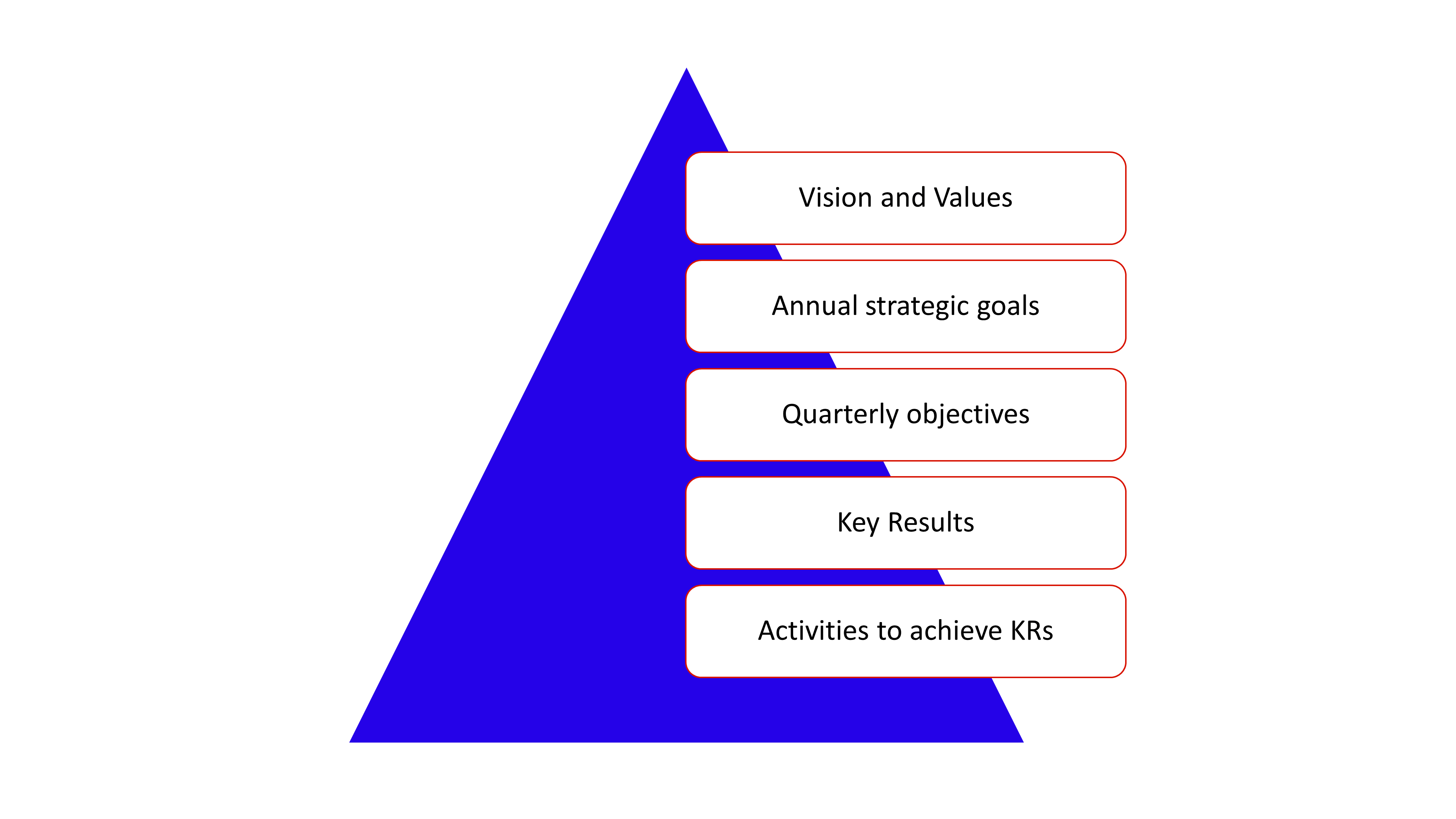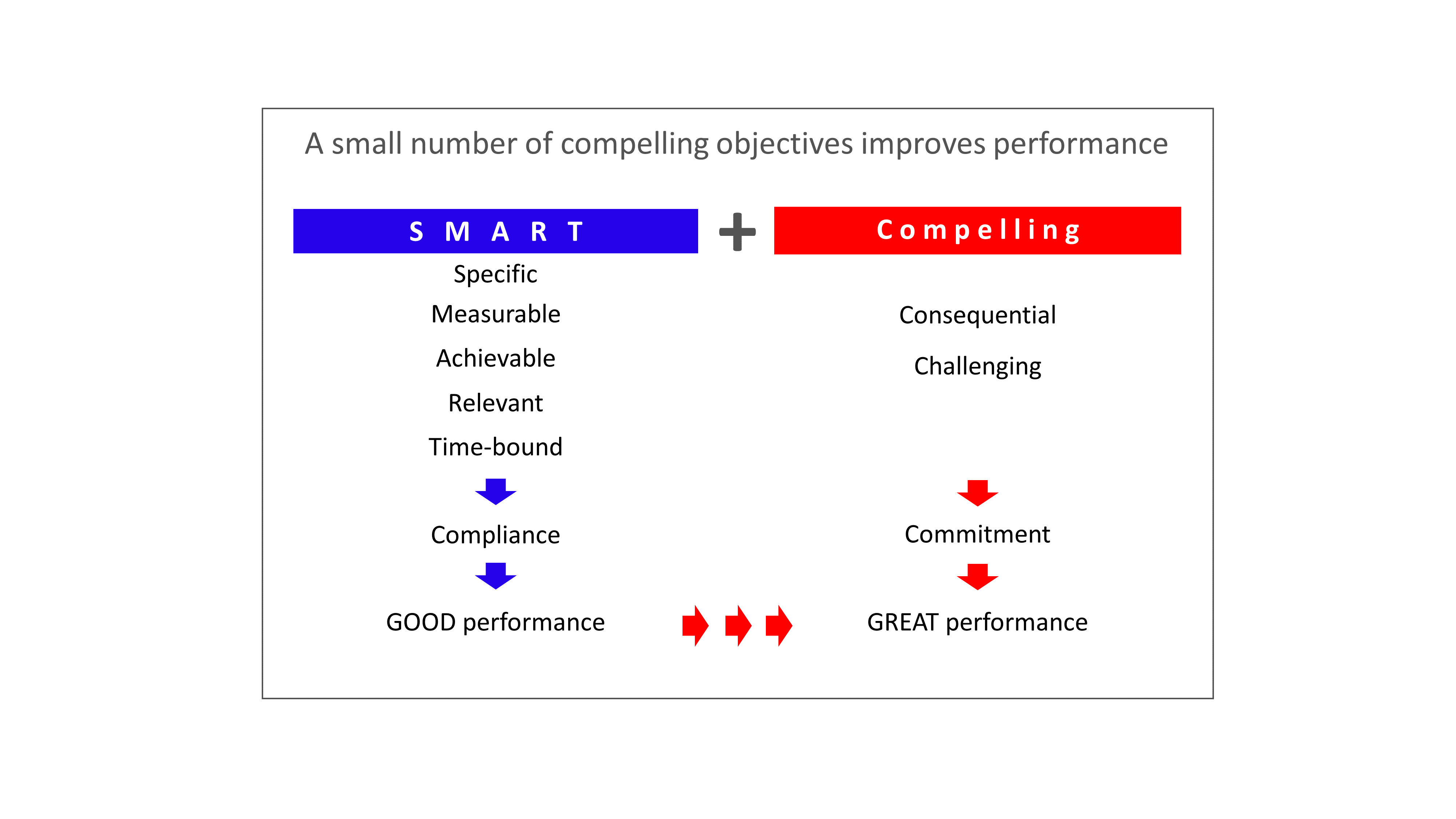Clarifying objectives
-
 Overview
Overview -
 Exercises
Exercises
Overview
In practice: Enabling your staff to see the alignment between the organisation's priorities and their own individual objectives.
The long term aspirations of an organisation have to get broken down into the tasks and activities that people perform on a daily basis. There are many models for how this happens, but all basically move from a big picture, long term aspiration (which we have termed ‘Vision and Values’ in the diagram below) to an organisational strategy (‘How the organisation will go about realizing its Vision and Values’) then to Annual Strategic Goals, then to quarterly team and individual Objectives, along with their measurable Key Results to be achieved, and finally to the daily activities designed to make them happen.

This move from a long term big picture for the organisation as a whole to individual objectives that are immediate and specific has traditionally been called Management by Objectives, and is currently championed by Google under the heading of the OKR (Objectives and Key Results) process. In Google, for example, every individual has their own OKRs, and these are openly available for viewing by everyone else in the business.
The process is described below for individual objectives. It applies in just the same way to setting team objectives. Team objectives are more than just the sum of individual team members' objectives, and should be discussed by the team as a whole starting with the question "What are we trying to achieve as a team?". You can find out more about setting team objectives here.
The real power of this objective setting process lies in the way they are set by negotiation between a person and their boss, and the proven way1 that transparent, measurable and stretching objectives:
- Motivate people.
- Help them focus and prioritise their efforts.
- Communicate everyone’s priorities, what they are working on and why.
- Keep people aligned with each other’s work.
- Quantify progress towards business aims.
So, let’s look at the how you can use the OKR process and get really focused on what matters most:
- Setting objectives
- Prioritising what's essential
- Deciding key result areas
- Pinpointing tasks and activities
- Dropping inessential work
You can find exercises covering all these areas by clicking the Exercises button at the top of the page.
Setting SMART, compelling objectives
The acronym SMART has been used for over 30 years to remind people of best practice for setting objectives - they should be specific, measurable, achievable, relevant, and time-specific. Specific ambitious targets definitely improve performance – there’s a wealth of evidence behind this1.
More recent research has also shown they need to be ‘challenging and meaningful’ to really fire up you or the team. The term ‘compelling’ has been used to capture this ‘challenging and meaningful’ characteristic. Objectives should be so compelling that people will want to perform to their very best to achieve them.

Of course, if you set very challenging objectives there is a chance that you won’t hit the target. You don’t want to set them so easy that you’re bound to succeed – that’s not challenging at all – but nor should they be so unrealistic that people lose heart. As a rule of thumb, set targets that you have a 50% -> 70% chance of reaching.
In practice, you, or your team will want to set your objectives in conversation and negotiation with your manager. Set them to cover a timeframe that is right for your job. This may be quarterly, or maybe on an annual basis. The shorter the time frame, the more focus they will bring, but you should be monitoring your progress on a weekly or monthly basis anyway.
You will want no more than 5 objectives, whether you are considering them over a one year or a quarterly period. Bear in mind that in the OKR process, objectives are further broken down into Key Results which give you finer detail to keep progress on track, and finally to a list of tasks and activities.
Prioritising
If you find, when you reflect and try to produce a small number of key objectives, that you seem to have far too many and varied tasks, what should you do? How do you grab a magic wand and turn a long list of activities into something more focused and manageable?
You have to go back to basics, decide what’s essential and what’s not, and strip out everything that doesn’t have a straight line to the core of what you and your team are being asked to do.
There are many ways of doing this. ‘The 5 Why’s’ is described below, and there’s another process called ‘Have to do, want to do, have resources to do’ shown in the Exercises section. These exercises focus specifically on prioritising objectives. There is a whole section devoted to ways of prioritising tasks and workload here.
The ‘the 5-why’s process’ is one good way of trimming the list and making life clearer – for yourself and/or your team.
- First, make a list of everything you or your team are spending time on.
- Next: go through the list and ask “Why are we doing this?” “To what end?”. You’ll find that many tasks will fall together into groups. Some groups of activities will be more important and central to your work than others. Put the least important groups and tasks away to one side. We’ll look at them again in the ‘What to Drop exercise below.
- Repeat the process as many times as you need to, continually comparing the different items on the list. Ask yourself if you can drop some activities because they are not as important right now for you to achieve what you want to achieve. The idea is to trim your list to the absolutely essential. You want to aim to finish up with just 3 – 5 groups.
- Now you can re-set your primary objectives. Look at each of the final groups you are left with. Take a ‘helicopter view’ of each group and write an overview objective for the group if you possibly can. Use the ‘SMART and compelling’ idea explained above to make the objective really motivational.
- You will come back these groups when we look at Key Result Areas below.
Key Result Areas
If you have followed one of the processes above, you should have between 3 and 5 groups, each with a ‘top-line’ SMART and compelling objective. You now need to go through a similar process for each of the groups picking out the most important results to aim for. These are the results you will need to achieve to give you a good chance of hitting your objective. Here’s an example for a single objective:
Objective: Implement v3.0 - update content by end Q1 2018
Key Results:
- Complete current 'Content Update' programme by end Jan 2018
- Update six-stage improvement model by end Jan 2018
- Write Team Leader's Guide by end Q1 2018
Pinpointing tasks and activities
The final step is to list and prioritise the tasks and activities you and the team need to get done to get those Key Results.
Dropping inessential work
Now comes the final, and sometimes the hardest, part.
You have decided to focus relentlessly on your OKRs. You have agreed them with your manager, and shared them publicly. This will help to push your achievement to a new high. But what do you do about the jobs you were doing, but didn’t make the cut to your new list? Maybe some other teams depended on you doing those jobs. Maybe there were some things you really liked doing.
Well, firstly, it’s a good idea to be talking and listening to your ‘customers’ and colleagues, and your manager, as you go through the objective setting process. That way, people will better understand the decisions you and your manager have made.
Secondly, if the rest of the organisation is using this process – which they should be – they should understand the rationale behind your decisions.
Workplaces are places where trade-offs need to be made between all the things we’d like to do, and what our resources will stretch to. The OKR process is designed to sort out what matters most, and what doesn’t. You may need to have some difficult conversations to explain why your own and/or your team focus has changed. But knowing you have gone through a sound process and kept people informed as you did it should ease that discussion.
1. See, for example, "Motivate employee performance through goal-setting", Latham - in Handbook of principles of organisational behaviour, Locke(ed) Blackwell, 2000
Exercises
Exercise - Setting SMART Compelling Objectives
This exercise - for teams or individuals - helps bring real focus to your priorities.
Exercise - The 5 Why's
An exercise to help you / your team group a long to-do list of activities and tasks into a more focused and prioritised set of objectives.
Exercise - Have to Do, Want to Do, Have Resources to Do
A technique for prioritising your / your team's work
Exercise - Prioritising
Four useful tools to help turn the mountain of work into manageable steps, with the most important at the top.
Exercise - From Objectives to Key Results to Tasks
This exercise helps you break down your / your team’s 3 – 5 main objectives into ‘Key Result’ areas, and then into specific tasks and activities that will focus your day to day work.
Exercise - Dropping inessential work
Some tips on making sure you can focus on your top priorities.
